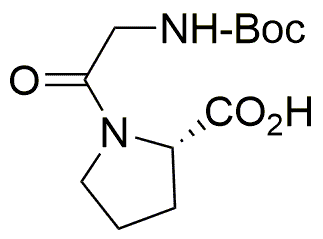Boc-Gly-Pro-OH is widely utilized in research focused on:
- Peptide Synthesis: This compound serves as a key building block in the synthesis of peptides, particularly in the pharmaceutical industry where custom peptides are needed for drug development.
- Bioconjugation: It is used in bioconjugation processes to attach biomolecules to surfaces or other molecules, enhancing drug delivery systems and diagnostics.
- Research in Protein Engineering: Researchers employ this compound to modify proteins, allowing for the study of protein interactions and functions, which is crucial in biotechnology.
- Development of Therapeutics: The compound plays a role in the development of therapeutics targeting specific diseases, particularly in oncology and immunology, by facilitating the design of more effective drug candidates.
- Analytical Chemistry: It is used as a standard in analytical methods, helping researchers ensure accuracy in the quantification of similar compounds in complex mixtures.
Informations générales
Propriétés
Sécurité et réglementation
Applications
Boc-Gly-Pro-OH is widely utilized in research focused on:
- Peptide Synthesis: This compound serves as a key building block in the synthesis of peptides, particularly in the pharmaceutical industry where custom peptides are needed for drug development.
- Bioconjugation: It is used in bioconjugation processes to attach biomolecules to surfaces or other molecules, enhancing drug delivery systems and diagnostics.
- Research in Protein Engineering: Researchers employ this compound to modify proteins, allowing for the study of protein interactions and functions, which is crucial in biotechnology.
- Development of Therapeutics: The compound plays a role in the development of therapeutics targeting specific diseases, particularly in oncology and immunology, by facilitating the design of more effective drug candidates.
- Analytical Chemistry: It is used as a standard in analytical methods, helping researchers ensure accuracy in the quantification of similar compounds in complex mixtures.
Documents
Fiches de données de sécurité (FDS)
La FDS fournit des informations de sécurité complètes sur la manipulation, le stockage et l’élimination du produit.
Spécifications du produit (PS)
Le PS fournit une description complète des propriétés du produit, notamment sa composition chimique, son état physique, sa pureté et les exigences de stockage. Il détaille également les plages de qualité acceptables et les applications prévues du produit.
Certificats d'analyse (COA)
Recherchez des certificats d'analyse (COA) en saisissant le numéro de lot du produit. Les numéros de lot et de lot se trouvent sur l'étiquette d'un produit, après les mots « Lot » ou « Lot de fabrication ».
Numéro de catalogue
Numéro de lot/série
Certificats d'origine (COO)
Ce certificat d'exploitation confirme le pays dans lequel le produit a été fabriqué, et détaille également les matériaux et composants utilisés et s'il est issu de sources naturelles, synthétiques ou autres sources spécifiques. Ce certificat peut être requis pour les douanes, le commerce et la conformité réglementaire.
Numéro de catalogue
Numéro de lot/série
Fiches de données de sécurité (FDS)
La FDS fournit des informations de sécurité complètes sur la manipulation, le stockage et l’élimination du produit.
DownloadSpécifications du produit (PS)
Le PS fournit une description complète des propriétés du produit, notamment sa composition chimique, son état physique, sa pureté et les exigences de stockage. Il détaille également les plages de qualité acceptables et les applications prévues du produit.
DownloadCertificats d'analyse (COA)
Recherchez des certificats d'analyse (COA) en saisissant le numéro de lot du produit. Les numéros de lot et de lot se trouvent sur l'étiquette d'un produit, après les mots « Lot » ou « Lot de fabrication ».
Numéro de catalogue
Numéro de lot/série
Certificats d'origine (COO)
Ce certificat d'exploitation confirme le pays dans lequel le produit a été fabriqué, et détaille également les matériaux et composants utilisés et s'il est issu de sources naturelles, synthétiques ou autres sources spécifiques. Ce certificat peut être requis pour les douanes, le commerce et la conformité réglementaire.


